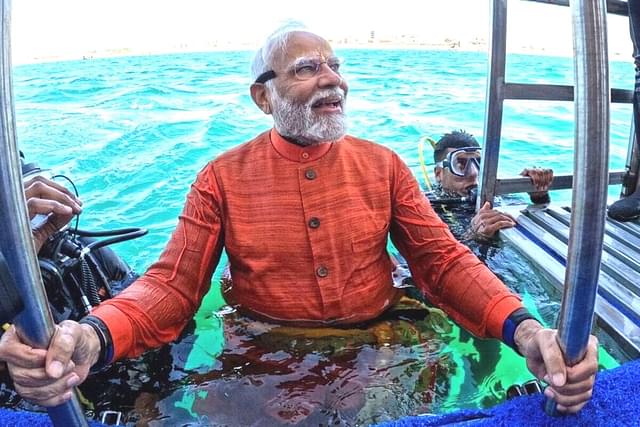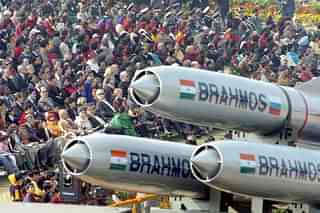Culture
Adventure, Pilgrimage, Education: How Scuba Diving In Dwarka Can Be A Unique Experience In Religious Tourism
Aravindan Neelakandan
Feb 29, 2024, 03:31 AM | Updated Feb 29, 2024, 01:46 PM IST
Save & read from anywhere!
Bookmark stories for easy access on any device or the Swarajya app.

On 25 February 2024, Narendra Modi, the 73-year-old Prime Minister of India, embarked on a scuba diving expedition into the sea at the historic coastal town of Dwarka, known for its association with the submerged kingdom of Krishna's legendary city.
With peacock feathers tucked into his suit, he engaged in meditation underwater, while his scuba gear prominently displayed the Indian tricolour. Upon resurfacing, the Prime Minister described the experience as divine.
Setting aside considerations of his religiosity, potential electoral motives as viewed by political analysts, and criticisms from his detractors, the Prime Minister's actions highlight a significant potential that the nation should harness.
In India, there are several scuba diving destinations that cater mostly to adventurous tourists. However, the country's overall potential for scuba diving tourism remains largely untapped. The cost is often prohibitive for the average Indian tourist.
Yet, beyond the natural beauty, the thrill of adventure, and the allure of witnessing the undersea marine environment, each offering its own rewards and elevating experiences, what could attract the average Indian to scuba diving?
The Prime Minister has provided a compelling answer— an element of historical mystery, the sanctity of a national epic, and the excitement of experiencing all of it underwater.
Dwarka started as a coastal settlement and later developed into a significant port city. Despite being abandoned in the late Bronze/early Iron Age, it maintained its status as a port town from the early centuries of the Common Era through the medieval and early modern periods. Therefore, not all structures found underwater in Dwarka necessarily date back to the time of Krishna.
However, the underwater site does contain ancient artefacts and structures that align archaeologically with the Harappan era and religiously with the times of Sri Krishna.
This convergence of history and religious literature is evident in the submerged ruins of Dwarka. There is a possibility that the artefact or stone structure one encounters beneath the waves once belonged to the era when Krishna ruled this port city.
If scuba diving, complete with the necessary equipment, gear, and safety measures, can be established as an institutionalised attraction in Dwarka, it has the potential to draw numerous pilgrims. This would combine adventure sports tourism, devotional pilgrimage, and educational expeditions into one unique experience.
With a significant influx of pilgrims already visiting Dwaraka, offering a cost-effective scuba diving experience combined with a brief meditation sanctioned by health authorities in the waters of Dwaraka presents an attractive package for holistic pilgrimage tourism.
This approach can provide a more engaging introduction to the mysteries of ancient civilisation for younger generations. A few moments spent underwater in Dwaraka could potentially counter years of indoctrination that persists in our history textbooks. It could also inspire more individuals to pursue careers as marine archaeologists.
The Archaeological Survey of India could consider establishing an underwater exhibition or a brief guided tour, though caution must be exercised to avoid pseudo-history and exaggeration. Multiple narratives could be presented, including a devotional one for the religiously inclined and a historically accurate one for the curious, without these narratives being mutually exclusive.
The Dwarka dive showcased a vision that went beyond normal limitations while drawing its inspiration from India's spiritual core.
If authorities and related departments can participate in this vision and make underwater meditation and visits possible for interested pilgrims, India could become a leader in innovative pilgrimage tourism, combining devotion, knowledge, and adventure through underwater exploration. Underwater adventure and scuba diving exist at many coastal tourist hubs but such a combination of devotion-knowledge-adventure would exist only in India.
Dwarka's tourism industry will reach new heights under the sea.
Save & read from anywhere!
Bookmark stories for easy access on any device or the Swarajya app.
Support Swarajya's 50 Ground Reports Project & Sponsor A Story
Every general election Swarajya does a 50 ground reports project.
Aimed only at serious readers and those who appreciate the nuances of political undercurrents, the project provides a sense of India's electoral landscape. As you know, these reports are produced after considerable investment of travel, time and effort on the ground.
This time too we've kicked off the project in style and have covered over 30 constituencies already. If you're someone who appreciates such work and have enjoyed our coverage please consider sponsoring a ground report for just Rs 2999 to Rs 19,999 - it goes a long way in helping us produce more quality reportage.
You can also back this project by becoming a subscriber for as little as Rs 999 - so do click on this links and choose a plan that suits you and back us.
Click below to contribute.





